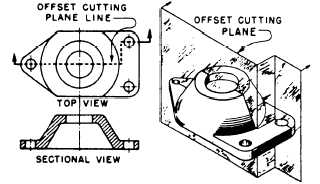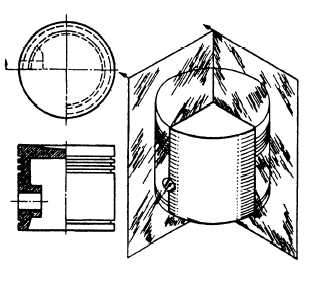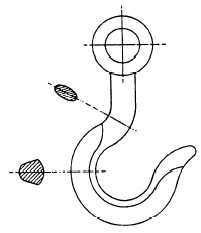Section A-A in view D is known as a full section
because the object is cut completely through.
OFFSET SECTION.—In this type of section, the
cutting plane changes direction backward and forward
(zig-zag) to pass through features that are important to
show. The offset cutting plane in figure 3-18 is
positioned so that the hole on the right side will be
shown in section. The sectional view is the front view,
and the top view shows the offset cutting plane line.
HALF SECTION.—This type of section is
shown in figure 3-19. It is used when an object is
symmetrical in both outside and inside details.
One-half of the object is sectioned; the other half is
shown as a standard view.
The object shown in figure 3-19 is cylindrical and
cut into two equal parts. Those parts are then divided
equally to give you four quarters. Now remove a quar-
ter. This is what the cutting plane has done in the
pictorial view; a quarter of the cylinder has been re-
Figure 3-18.—Offset section.
Figure 3-19.—Half section.
moved so you can look inside. If the cutting plane had
extended along the diameter of the cylinder, you would
have been looking at a full section. The cutting plane in
this drawing extends the distance of the radius, or only
half the distance of a full section, and is called a half
section.
The arrow has been inserted to show your line of
sight. What you see from that point is drawn as a half
section in the orthographic view. The width of the
orthographic view represents the diameter of the
circle. One radius is shown as a half section, the other
as an external view.
REVOLVED SECTION.—This type of section
is used to eliminate the need to draw extra views of
rolled shapes, ribs, and similar forms. It is really a
drawing within a drawing, and it clearly describes the
object’s shape at a certain cross section. In figure 3-20,
the draftsman has revolved the section view of the rib
so you can look at it head on. Because of this revolving
feature, this kind of section is called a revolved
section.
REMOVED SECTION.—This type of section is
used to illustrate particular parts of an object. It is
drawn like the revolved section, except it is placed at
one side to bring out important details (fig. 3-21). It is
Figure 3-20.—Revolved section.
Figure 3-21.—Removed section.
3-7







